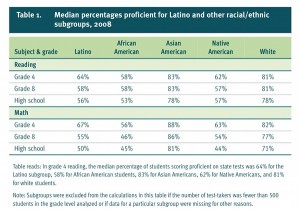Posted by Elena del Valle on August 16, 2010

Reading, math scores by race/ethnicity – click to enlarge
Chart, photo: Center on Education Policy, CommunicationWorks
A colleague pondered out loud the other day: “In future decades how will marketers target America’s increasingly large emerging markets?” Although Asian American students are doing better than their emerging market counterparts, reading (and math) proficiency is low among Latinos and blacks compared to other students. If the young adults of the future can’t read will general marketing emphasize the visual and audio formats that they are able to consume?
In spite of some modest gains in test scores among Latinos in recent years, education gaps appear to be a serious problem that is not going away anytime soon. According to a recent report on Latino performance in school, in California, the state with the largest Latino enrollment, Latino students were the lowest-performing subgroup in reading at all grade levels.
On the last day of June 2010 the Center on Education Policy (CEP) released a series of reports on the performance of Latino, African American, Asian American, Native American and white students on state reading and math tests. The reports also examine the implications of CEP’s findings about achievement for each ethnic/racial subgroup.
Although Latinos still perform well below Asian American and white students on state tests and many issues remain to be resolved when it comes to education, especially in states with a high percentage of Latinos, according to the results of the reports, some Latino students are performing better on state reading and math tests than in the past.
Between 2002 and 2008 for grades four, eight and the high school grade assessed for the No Child Left Behind (NCLB) Act the performance of Latino students on state reading and math tests improved in most states.
At the same time according to the report as a group, African American students were often the lowest-performing racial/ethnic subgroup in 2008 on state reading and math tests at grades four, eight, and the high school tested in the majority of the states with sufficient data, as well as in the nine states with the highest numbers of African American test-takers. In contrast, as a group, Asian American students often outperformed other racial/ethnic subgroups in reading and math at grades four, eight, and the high school grade tested. In high school reading, however, white students did better than Asian American students in most states with sufficient data and sufficiently large Asian subgroups.
Despite gains, the Latino subgroup still remains among the lower-performing racial/ethnic subgroups on state tests. Across all states with adequate data, median percentages proficient for Latino students in reading and math in 2008 were well below those of the Asian and white subgroups. For example, in grade eight math the medians were 55 percent for Latino students, compared with 86 percent for Asian students and 77 percent for white students. Latino students were somewhat above or similar to medians of African Americans at 46 percent and Native Americans at 54 percent.

Jack Jennings, president and CEO, CEP
In 2008, Latino students were the lowest-performing racial/ethnic subgroup in at least one subject/grade combination in 11 states with sufficient data for the study. The achievement for Latino students in 2008 was slightly more negative in the five states that together enroll more than 70 percent of the nation’s Latino students California, Texas, Florida, New York and Arizona.
“These increases in test scores for Latino students are encouraging, but the achievement level of Latino students is nowhere near where it has to be,” said Jack Jennings, president and chief executive officer, CEP. “Latino students are the largest ethnic minority group in many states and are the fastest-growing nationally, and therefore it is crucial to improve achievement for these students.”
CEP analyzed 2008 state test results and trends since 2002 in the Latino-white achievement gap and in the percentages of Latino students reaching various achievement levels. Their findings were drawn from test data, gathered by CEP, from all 50 states.
The Latino student report indicates that states with increases for Latino fourth graders since 2002 outnumbered states with decreases at the basic, proficient, and advanced achievement levels. Latino students have also improved achievement at grades four, eight, and the tested high school at a fast enough rate to narrow gaps in the percentage reaching proficient in reading and math in a large majority of the states with sufficient data. Since 2002 gaps narrowed more often than they widened, according to the mean test scores results.
The researchers concluded that the “relatively low performance of Latino students, who in less than a generation will comprise roughly three in ten American children, is an urgent issue. The nation’s economic and social well-being will be compromised without efforts at all levels of government to develop policies to increase achievement for Latino young people.”
Based in Washington, D.C., and founded in January 1995 by Jack Jennings, the Center on Education Policy is “a national, independent advocate for public education and for more effective public schools.” According to a press release the Center represents no special interests. The Center strives “to help citizens make sense of the conflicting opinions and perceptions about public education and create conditions that will lead to better public schools.”
Posted by Elena del Valle on August 13, 2010

Hispanic New York A Sourcebook
In June, Columbia University Press published Hispanic New York A Sourcebook (Columbia University Press, $29.95), a book edited by Claudio Iván Remeseira, founder and director of the Hispanic New York Project which is hosted by Columbia University’s American Studies Program, about the Hispanic history of the city and its Latino communities. It may also be published in Spanish by a Latin American publishing company.
The book was designed as an anthology of scholarly, literary, autobiographical, and journalistic writings for high school and college students and based on a seminar taught by the editor and Roosevelt Montás, a colleague at Columbia University. It was meant to be a companion book to Hispanic New York: A Cultural Guide, a title that is still under production.
In addition to Remeseira the 547-page softcover book is the work of fourteen men and nine women: Jack Agueros, Theodore S. Beardsley Jr., Paul Berman, Dionisio Cañas, Ruby Danta, Margarite Fernández Olmos, Frank M. Figueroa, Gabriel Haslip-Viera, Carmen Dolores Hernández, Orlando José Hernández, José Marti, Ed Morales, Antonio Muñoz Molina, Frances Negrón-Muntaner, Lizabeth Paravisini-Gebert, Luis Pérez-Oramas, Milagros Ricourt, Clara Rodriguez, Virginia Sánchez Korrol, Roberto Suro, Bernardo Vega, Walt Whitman, and Ana Cecilia Zentella.

Claudio Iván Remeseira, editor, Hispanic New York A Sourcebook
“Since the moment I had the idea of producing this book to the moment it reached the bookstores, it was almost three years. But I started collecting the material that eventually made up the book around 2001. So you can safely say that the book took almost a decade in the making, and the last three years of that period to come into fruition,” said Remeseira by email when asked how many years the project required.
The book is divided into two main sections, People and Communities and Cultural Hybridizations, and 23 chapters: Introduction, The Evolution of the Latino Community in New York, A Vindication of Cuba, Memoirs of Bernardo Vega, Halfway to Dick and Jane, New York Teetering on the Heights, The Hispanic Impact Upon the United States, In Search of Latinas in U.S. History, 1540-1970s, The Spanish Element in Our Nationality, Racial Themes in the Literature, The Emergence of Latino Panethnicity, Creole Religions of the Caribbean, New York City Center and Transit Point for Hispanic Cultural Nomadism, Puerto Rican Voices in English, Spanish in New York, Spanish in New York a Moving Landscape, New York’s Latin Music Landmarks, The Story of Nuyorican Salsa, Mariachi Reverie, The Art of Babel in the Americas, The Life and Passion of Jean-Michel Basquiat, A Splendid Outsider, and Carlos Gardel in New York.

Click here to buy Hispanic New York: A Sourcebook
Comments:
Filed Under: Books
Posted by Elena del Valle on August 12, 2010
Calysto Communications, a boutique public relations agency with a focus on communications, is looking for PR consultants with experience in the Latin American and South American markets. The ideal candidate is an experienced PR professional with telecom experience (preferred) or technical experience (required), who is looking for some flexibility in his or her schedule or has their own PR consultancy. We need you to be a strategic thinker who is not afraid to jump in and pitch if necessary.
Click here for the full text of PR Consultant – CALA & Latin and South American Focus
Posted by Elena del Valle on August 11, 2010

Photos: Babyspot.com, Todobebe.com
Our nation’s birth rate has declined in the past 20 years. During that time period new mothers have become more likely to be older, better educated and less likely to be white. Fewer white women are having babies while an increasing number of babies are born of Hispanic moms, according to a recently released report. One in four births in 2008 was to a Hispanic mother. Although white women still represented more than half of mothers of newborns that year that was less than the 65 percent of white women who gave birth in 1990.
More than half of mothers of newborns in 2006 had spent some time in college which was an improvement over the 41 percent of women who had some college education in 1990. Older mothers of newborns, those 35 years of age and older, were much more likely to have some college education (71 percent).

James Rivera, co-founder, Babyspot
“I do see evidence of your findings, our site agrees with most of your data. Our traffic has increased in the last year, it’s around 30 percent increase,” said James Rivera, co-founder and chief executive officer, BabySpot, Inc. when asked if he sees evidence of these trends.
Women are also waiting longer to have babies than they did twenty years ago. While in 1990, teenagers had a higher share of all births (13 percent) than did women 35 years of age and older (9 percent) by 2008, the reverse was true with 10 percent of births to teens and 14 percent to women ages 35 and older. This increase in older mothers held across ethnic groups.

More unmarried women by far (41 percent) had babies in 2008 than in 1990 (28 percent). Black unmarried women were the most likely to have babies compared white and Hispanics.
“There are 4M (million) births per year and 1M (million) are to Spanish speaking parents, 25 percent of the newborns. This has been a constant for the past two years and is based on U.S. Census Live Birth Statistics,” said Cynthia Nelson of Todobebe.com. “We have a 20 percent increase in moms that join Todobebe in the past year and about 55 percent of our moms are pregnant at any one give time. There is no one month during the year that there are more births with the exception of the slight increase in September (December holidays trigger this event).”
In 2008, there were 4.3 million births in our country slightly more than in 1990 when there were 4.2 million. Between 2003 to 2007 the number of births increased each year and then declined by about 66,000; the researchers believe the decrease is the result of the economic downturn.

Immigrants tend to have higher birth rates than the native born although those rates have declined in recent years. The share of births to foreign-born mothers, 15 percent of U.S. births in 1990, grew 60 percent through 2004. In 2004, births to foreign-born women represented the majority of Hispanic (61 percent) and Asian (83 percent) births.
Although it is hard to think about our nation’s demographic profile in 40 years, according to Pew Research Center population projections and assuming current trends remain steady, 82 percent of the nation’s population growth through 2050 will be produced by immigrants who arrived in our country after 2005 and their descendants. The researchers estimate 142 more million people will fuel our population between 2005 and 2050; of these 50 million will be the children and grandchildren of new immigrants.
The report, The New Demography of American Motherhood, was written by Gretchen Livingston and D’Vera Cohn of the Pew Research Center based on data from the National Center for Health Statistics and the Census Bureau. It also included the findings of a national Pew Research Center survey about parenthood.
Posted by Elena del Valle on August 9, 2010

Steve Haase, partner, ThoughtLead
Photo: ThoughtLead
A podcast interview with Steve Haase, partner, ThoughtLead is available in the Podcast Section of Hispanic Marketing & Public Relations, HispanicMPR.com. During the podcast, Steve discusses how to grow your online presence with free events with Elena del Valle, host of the HispanicMPR.com podcast.
Steve, who is passionate about copy writing, social media, and entrepreneurship, is striving to establish himself as an up and coming voice in online marketing. Prior to working with ThoughtLead, Steve was a member of the United States Navy Band, where he served as a trumpet instrumentalist for five years.
Steve’s business experience also includes growing two small enterprises from the ground up, as a founder of the Prism Brass Quintet and an independent contractor with Vector Marketing. Steve earned his masters degree in music from the University of Maryland, College Park; and his Master of Arts degree in Conscious Evolution from the Graduate Institute in Milford, Connecticut.
To listen to the interview, scroll down until you see “Podcast” on the right hand side, then select “HMPR Steve Haase” click on the play button below or download the MP3 file to your iPod or MP3 player to listen on the go, in your car or at home. To download it, click on the arrow of the recording you wish to copy and save it to disk. The podcast will remain listed in the August 2010 section of the podcast archive.
Posted by Elena del Valle on August 6, 2010

Facebook Marketing: Designing Your Next Marketing Campaign
Photos: Que Publishing
In July 2010 Facebook announced it has 500 million users (although on another page of the Facebook website the company’s own description listed the day of this writing 400 million users who have returned to the site in the last 30 days). Founded in February 2004, Facebook is described in the About Facebook heading of the Press section of the company website as “a social utility that helps people communicate more efficiently with their friends, family and coworkers. The company develops technologies that facilitate the sharing of information through the social graph, the digital mapping of people’s real-world social connections. Anyone can sign up for Facebook and interact with the people they know in a trusted environment.”
The Statistics page of the Press section of the Palo Alto, California based company indicates 70 percent of its users are outside the United States. At the same time it seems to be popular with big companies: Two-thirds of comScore’s Top 100 websites in the United States and half of comScore’s Global Top 100 websites have integrated with Facebook, according to the data on that same page.
Perhaps as a result it seems everybody is thinking about, wants to, or has a business page on Facebook although curiously in the company’s own description the utility is for “friends, family and coworkers.” At the same time whether for personal, business or combination profiles there have been a number of concerns over the life of the website and especially recently about privacy and the company’s efforts to bank on member data to make a profit.

Author Justin Levy
Earlier this year Facebook changed its default privacy settings to allow third-party partner websites described as partners to access information from user profiles whenever they wanted to unless users went back to their profiles after the new policy was announced to block that use. Millions of users were said to have complained and as many as 25 million were thought to have closed their accounts in protest before the company responded.
As director of Business Development, Marketing and Client Relations at New Marketing Labs Justin Levy makes his living with Facebook, in part. The company he works for offers consulting services to middle and large sized companies that want to leverage their social media presence. According to his bio, his clients include Sony, Microsoft, Citrix Online, SAS, and Molson Coors. Earlier this year, he published the second edition of Facebook Marketing: Designing Your Next Marketing Campaign (Pearson Education, Inc., $24.99).
In the 195-page softcover book he discusses his thoughts on Facebook as a social media business tool. He addresses establishing a presence, creating ads on Facebook, privacy, using Facebook Connect and Live Stream Box to reach potential customers outside Facebook, reputation monitoring, widgets and apps, and sweepstakes to build traffic.
The book is divided into 11 chapters: From Dorm room to Boardroom: The Growth of Social Networks, Getting Around Facebook: The Basics, Establishing a Corporate Presence, Extending Facebook into the Interwebs: The Power and Reach of Facebook Connect, Facebook Advertising: How and Why You Should Be Using It, Extending the Experience with Facebook Apps, Addressing Privacy Concerns, Developing a Facebook Marketing Strategy, Using Facebook to Develop Communities, Best in Class, Shaking the Crystal Ball: What’s Next for Facebook.

Click here to buy Facebook Marketing
Comments:
Filed Under: Books
Posted by Elena del Valle on August 4, 2010
By Harald H. Vogt
Founder and chief marketer, Scent Marketing Institute

Harald H. Vogt, founder and chief marketer, Scent Marketing Institute
Photo: Scent Marketing Institute
This just in: A group called “Teens turning Green” chimes in on the safety (better, the lack thereof) of fragrances in consumer goods, body care products and fine fragrances that people buy to enjoy – or simply to smell better.
As sure as the kids go to camp, every summer the scent-adverse special interest groups pick up reports from organizations such as “The Campaign for Safe Cosmetics” that lament the fact that there are health risks resulting from “secret chemicals” in fragrance. Usually such advocacy groups are also anti-commerce and against aggressive marketing. At least with TTG that isn’t the case since they sell their own range of products via their web site while they criticize the products of others right next door. For just $130 the whole range can be yours’…
Click here to read the entire article Transparency – the new consumer demand
Posted by Elena del Valle on August 3, 2010
The Nellie Mae Education Foundation
Quincy, MA
The Nellie Mae Education Foundation (NMEF), New England’s largest public charity focused on education, seeks a Director of Communications. Through grant making, research and policy initiatives, and technical assistance the NMEF works with educational institutions and associations, cultural and community organizations, foundations, government agencies and others to encourage, establish, and maintain programs and services that promote student-centered learning education reform for all students, especially and essentially underserved learners.
Click here for the full text of Director of Communications
Posted by Elena del Valle on August 2, 2010
Are you tired of long drives commuting to work? Do you have small children at home? Do you just want to work part time or supplement your income? You can work from home. Really.
If you are a people person and have
A positive attitude
High ethical standards
A computer and know how to use it
A phone
High speed access to the Internet
Click here for the full text of Sales Associate
Posted by Elena del Valle on August 2, 2010

Debt as Percent of GDP – click to enlarge
These days everybody is talking or thinking about debt. The debt of the United States is a concern for many as our country falls deeper into debt to pay off wars and save banks, mortgage companies, car makers and the like from supposed failure. On the other side of the pond European nations like Greece, Portugal, Spain, Italy, and Ireland have been in the news lately due to their precarious debt related status.
The debt of nations is but one part of the problem. Across the west companies and individuals have over extended themselves, borrowing, some believe irresponsibly, in search of ever higher returns in the case of greedy companies and investors. Consumers have gotten into debt to buy bigger cars, houses, trips and some of the many trappings of today’s consumer driven society.
According to a recent an article in The Economist relying on data from the McKinsey Global Institute Ireland and Iceland approached the debt limit of eight and as much as ten times their gross domestic product (GDP). They are the the most noteworthy but not the only ones.
British bank debt as it relates to the country’s economy is significant as is the level of debt of corporations in Spain. The relationship between public and private sectors and debt issues is complex. If the government is needed to hold up companies with too much debt it will have an impact on countries with economies that appear healthy or less at risk than that of their neighbors.
Among countries with high debt to GDP ratios and a worsening outstanding debt compared to economic growth according to the article, Spain has surpassed Greece as the country in the worst position.
What does this mean to the average person in North America and Europe? Debt has caught up with governments, companies and consumers. Things are changing. No spending or cautious spending has replaced over-the-top spending. But astute observers say the many decades of living now with the promise to pay later will have a long term effect. Government promises and private sector conservatism now aren’t enough given that governments are having to come to the rescue of private sector behemoths and in many instances the countries themselves are in turbulent economic waters.
At the same time North America and many nations in Europe have large aging populations in varying proximity to their retirement years. That will mean fewer productive people in the workforce and more retirement dollars and healthcare dollars draining the system during belt tightening times. In all Organization for Economic Cooperation and Development (OECD) countries total spending on healthcare is rising faster than economic growth, causing the average ratio of health spending to GDP to rise 7.8 percent in 2000 to 9 percent in 2008. The causes behind the rising health spending, technological change, population expectations and population aging, are expected to continue to drive costs higher in the future.
In some countries the falling GDP and rising healthcare costs led to a marked increase in the ratio of health spending to GDP. For example, in Ireland, the percentage of GDP assigned to health increased from 7.5 percent in 2007 to 8.7 percent the following year while in Spain the increase was from 8.4 percent to 9 percent for the same years. In 2008, the United States spent $7,538 per person on health more than double the $3,000 average of all OECD countries. Although Norway and Switzerland, the next generous with healthcare budgets, spent 50 percent more than the OECD average.
The solution, some believe, is to grow economies while reducing spending. How will social benefit heavy societies like those in western Europe deal with growth requirements and the debt burden? Will they cut back healthcare, social and retirement benefits?
Entrepreneurs, an important source of future intellectual and financial wealth, may struggle since more than half of all new firms rely on debt finance, according to The Economist. Forward looking analysts indicate that to survive businesses will have to adapt to the economic situation and new mindset. In an ever tighter corporate environment with increased oversight and fewer entrepreneurial windows, it is likely marketers too will need to adjust to the new reality, demonstrating their worth with measurable results.

























